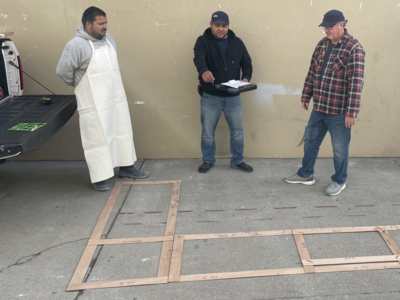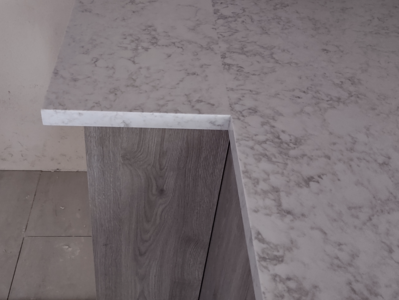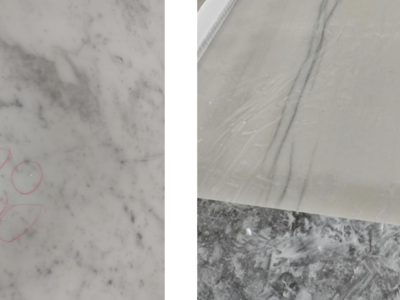The Fabrication Process Begins |
Job Review
A “Detail Sheet” and template review is performed the day after the template. The template maker, office staff and shop supervisor review all the information gathered at the template appointment. We identify any unanswered questions or issues that require clarifications. We also look for any changes between the actual job and the quoted job. Any additional requests made onsite at the template appointment are relayed to the showroom/contractor in the form of a change order. Questions, clarifications, and change orders are passed on to the showroom / contractor promptly and must be approved or answered quickly to avoid delays. | Layout
The shop staff lays out every job. We strive to maintain directionality and the flow of the material. This can be a challenge when using material with dramatic veins or directionality. Especially with L or U shaped kitchens. We can also use our computer optimization software to help layout a job. Virtual layout
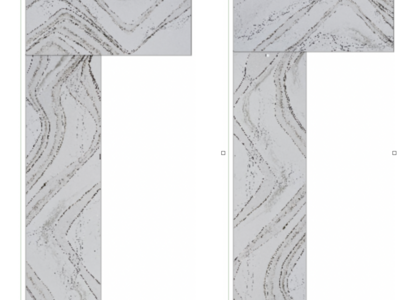 The staff may utilize computer software to try different layouts virtually. For example: abrupt intersecting veins will draw attention to the seam location and make it obvious. Laying out the job to maintain the flow and directionality creates a less conspicuous seam and improves the overall appearance of the job. | A Physical Layout
A physical layout may be requested as part of the fabrication process. Especially when using material with a lot of movement, directionality or veining. A layout must be requested at or before the template appointment. If a layout is requested, it is noted on the Detail Sheet. When the material is received at the shop, the customer is notified and an appointment set to perform the layout. If no layout is requested, we will move forward with the fabrication process assuming that the layout is at the discretion of the DCD staff. A physical layout with the homeowner at our San Leandro shop can help a customer visualize the finished product. It also helps to manage expectations. Layouts can cause delays in the process as the shop must wait for the layout appointment to be completed before they can begin fabrication. |
The Eye of the Beholder
Most clients rely on the expertise of DCD to layout the job. However, if no layout request is made, please do not second guess the layout after the job is complete. DCD layouts are based on years of experience and thousands of jobs taking into account the feedback from all those experiences. What looks “right” will differ from person to person. For example: The designer did not care for the white “blob” in the front of the bar although it is just part of the design. Turns out the homeowner loved it. Quartz Material Issues
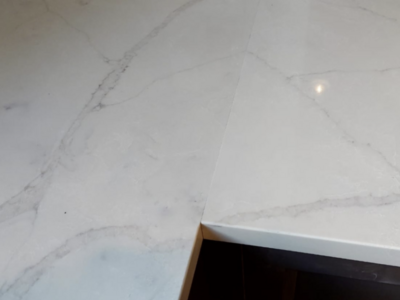 DCD fabricators also try to identify potential problems in the shop before the job is fabricated or arrives at the job site. For example, sometimes quartz slabs have slight shading differences, even when from the same batch. Two slabs from the same batch can still have subtle shading differences. Even though the DCD staff compares slabs, some shading differences are only visible in a certain light or angle. In the real world, what typically happens if there is some sort of problem, the manufacturer provides a free slab and then it’s up to the fabricator and showroom/contractor to make it right. |
Aesthetics
We do our best to line up veins with splashes and laminations as well. We try to maintain the flow of the material throughout the job, even when the splashes are multiple pieces. The size and number of slabs can limit our aesthetic options. For the best looking job, allow for plenty of material and or use book matched slabs. Same Slab Differences
Even a single slab will have variations from one side of the slab to the other. This photo is a one slab jobs where two areas of the same slab were brought together at a seam. This problem was solved by remaking the small section with a better match. | Natural Stone Material Issues
Virtually all natural stone slabs will have imperfections. Marble will almost certainly have white chalky pits. Granite will invariably have epoxy fill, fissures, flecks, pits and inconsistent sheen. Quartzite will typically contain fissures and can dramatically soak up water. When using any natural stone product, we have to assume that the person who selected the stone noticed and accepted the inherent blemishes associated with natural stone. DCD does not “fix” slabs by polishing or otherwise treating the surface. Some stone yards make this assertion in order to make a sale but it is not the case. When slabs are delivered to the shop, they are offloaded with care, stored in a secure staging area and protected. These blemishes do not occur during shipping, offloading or fabrication. They are present from the beginning. When slabs are purchased, the slabs are standing up and displayed under bright light. This makes the blemishes much more difficult to spot. Even so, DCD cannot be responsible for bringing potentially objectionable blemishes to the attention of the homeowner or designer. We hear it all: “those marks weren’t there when I bought it”. “You are the professional, you should have know I wouldn’t like it”. “I purchased the slab on line. You should have told me there were marks on it”. "Can you fix it"? Keep in mind, natural stone has no warranty. If it cracks or chips during fabrication or installation, it will be repaired to the best of our ability. It will not be replaced. Natural stone that cracks, chips, stains or leaves water marks is not a warranty issue. Sealing natural stone does not make it stain or water proof. Sealer allows time for a spill to be cleaned but wine, tea, coffee and such, if left on the countertop surface, will stain the stone. |








